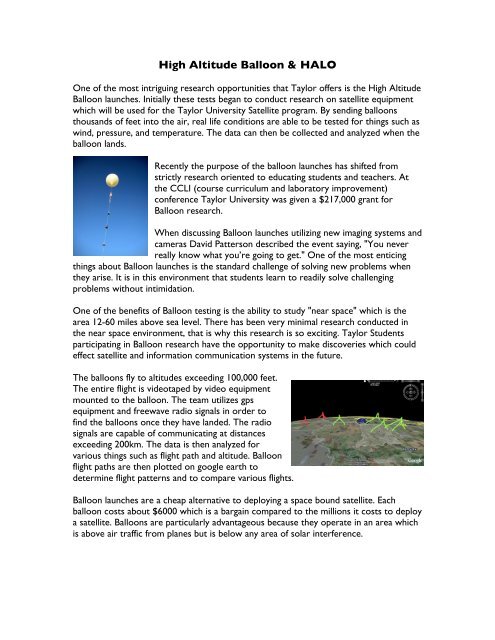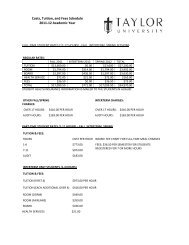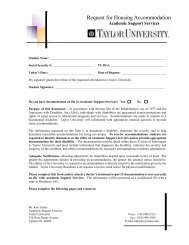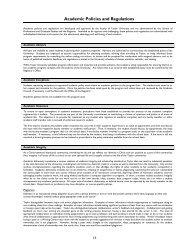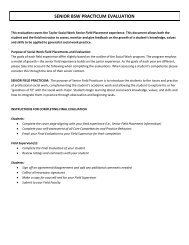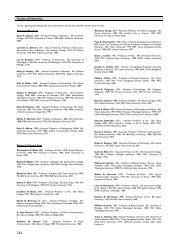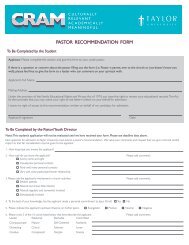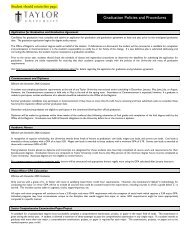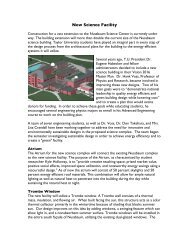High Altitude Balloon & HALO - Taylor University
High Altitude Balloon & HALO - Taylor University
High Altitude Balloon & HALO - Taylor University
Create successful ePaper yourself
Turn your PDF publications into a flip-book with our unique Google optimized e-Paper software.
<strong>High</strong> <strong>Altitude</strong> <strong>Balloon</strong> & <strong>HALO</strong><br />
One of the most intriguing research opportunities that <strong>Taylor</strong> offers is the <strong>High</strong> <strong>Altitude</strong><br />
<strong>Balloon</strong> launches. Initially these tests began to conduct research on satellite equipment<br />
which will be used for the <strong>Taylor</strong> <strong>University</strong> Satellite program. By sending balloons<br />
thousands of feet into the air, real life conditions are able to be tested for things such as<br />
wind, pressure, and temperature. The data can then be collected and analyzed when the<br />
balloon lands.<br />
Recently the purpose of the balloon launches has shifted from<br />
strictly research oriented to educating students and teachers. At<br />
the CCLI (course curriculum and laboratory improvement)<br />
conference <strong>Taylor</strong> <strong>University</strong> was given a $217,000 grant for<br />
<strong>Balloon</strong> research.<br />
When discussing <strong>Balloon</strong> launches utilizing new imaging systems and<br />
cameras David Patterson described the event saying, "You never<br />
really know what you’re going to get." One of the most enticing<br />
things about <strong>Balloon</strong> launches is the standard challenge of solving new problems when<br />
they arise. It is in this environment that students learn to readily solve challenging<br />
problems without intimidation.<br />
One of the benefits of <strong>Balloon</strong> testing is the ability to study "near space" which is the<br />
area 12-60 miles above sea level. There has been very minimal research conducted in<br />
the near space environment, that is why this research is so exciting. <strong>Taylor</strong> Students<br />
participating in <strong>Balloon</strong> research have the opportunity to make discoveries which could<br />
effect satellite and information communication systems in the future.<br />
The balloons fly to altitudes exceeding 100,000 feet.<br />
The entire flight is videotaped by video equipment<br />
mounted to the balloon. The team utilizes gps<br />
equipment and freewave radio signals in order to<br />
find the balloons once they have landed. The radio<br />
signals are capable of communicating at distances<br />
exceeding 200km. The data is then analyzed for<br />
various things such as flight path and altitude. <strong>Balloon</strong><br />
flight paths are then plotted on google earth to<br />
determine flight patterns and to compare various flights.<br />
<strong>Balloon</strong> launches are a cheap alternative to deploying a space bound satellite. Each<br />
balloon costs about $6000 which is a bargain compared to the millions it costs to deploy<br />
a satellite. <strong>Balloon</strong>s are particularly advantageous because they operate in an area which<br />
is above air traffic from planes but is below any area of solar interference.
<strong>Taylor</strong> <strong>University</strong> has conducted 65 successful high altitude balloon missions. <strong>Taylor</strong><br />
boasts an incredible 100% recovery record for every balloon experiment. The balloon<br />
experiments have been funded by the INSGC for five years running.<br />
<strong>HALO</strong> (<strong>High</strong> <strong>Altitude</strong> Launch Opportunity)<br />
The purpose of the <strong>HALO</strong> (<strong>High</strong> <strong>Altitude</strong> Launch Opportunity) project is to set up a<br />
high altitude communications network. <strong>HALO</strong> was so successful that a grant has already<br />
been given for the <strong>HALO</strong> 2 project. In the <strong>HALO</strong> project, multiple balloon launches<br />
were coordinated. <strong>Balloon</strong>s were launched from Indiana as well as seven other states.<br />
When one balloon would come over the radio horizon of another balloon they would<br />
link and start communicating. The potential for this technology is astounding. According<br />
to David Patterson, "the technology could provide at least text messaging, and perhaps<br />
voice communications, to all properly equipped stations in range of the balloons." There<br />
is also speculation that such technology could one day help produce a low cost internet<br />
solution.<br />
The <strong>HALO</strong> 2 Project is now currently under way with coordinated balloon launches<br />
scheduled for this spring.


